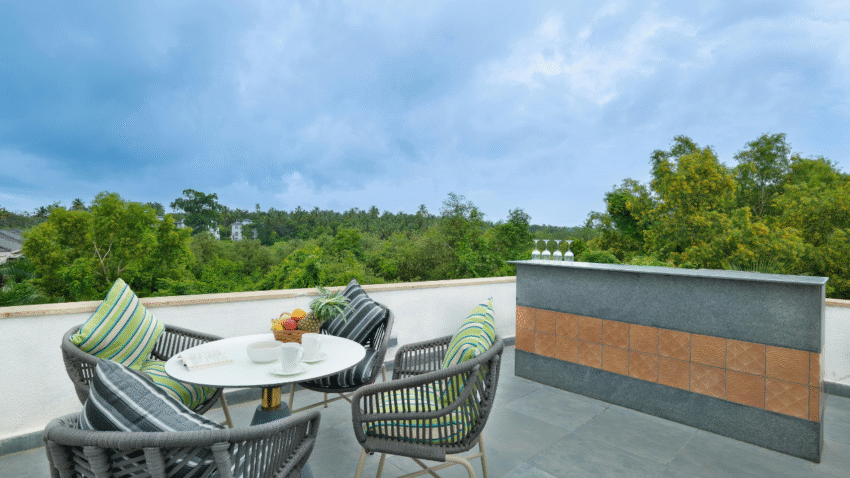Introduction
Potted plants are one of the simplest and most effective ways to add beauty, color, and life to your outdoor space. Learning how to use potted plants on a deck or patio allows you to personalize your area, improve comfort, and even grow herbs or vegetables for everyday use. Whether you have a sprawling patio or a small balcony-style deck, the right arrangement of potted plants can turn your space into a cozy retreat or a vibrant entertainment zone.
Why Potted Plants Matter for Decks and Patios
Adding plants in containers is more than just decoration—it’s a design choice with practical benefits:
- Flexibility: Move pots around to refresh the layout or follow the sun.
- Visual Appeal: Add color, height, and texture instantly.
- Privacy: Large pots and tall plants create natural screens.
- Functionality: Grow herbs, veggies, or fruit close to your kitchen.
- Mood Boosting: Greenery reduces stress and makes your space feel inviting.
Step-by-Step Guide to Using Potted Plants on a Deck or Patio
Step 1: Choose the Right Containers
Pick containers that suit your space and style:
- Clay or Terracotta Pots: Classic and breathable but heavier.
- Plastic or Resin Pots: Lightweight and durable, great for large plants.
- Wooden Planters: Rustic appeal, can be built into railing edges or corners.
- Metal Pots: Sleek and modern, but may heat up in strong sun.
- Self-Watering Planters: Perfect for busy homeowners or hot climates.
Pro tip: Make sure every container has proper drainage holes.
Step 2: Plan Plant Placement
Think about how plants will fit into your patio layout:
- Use tall plants in the corners for height and privacy.
- Place small or trailing plants on tables or railings.
- Group pots of varying sizes for depth and balance.
- Leave open areas for movement and seating.
Step 3: Select Plants for Your Climate and Purpose
Consider your climate, sunlight, and goals:
- For Color: Geraniums, petunias, marigolds, or impatiens.
- For Privacy: Bamboo, ornamental grasses, or small trees in large pots.
- For Fragrance: Lavender, jasmine, or rosemary.
- For Food: Basil, mint, peppers, or cherry tomatoes.
- For Shade: Ferns, hostas, or begonias.
Step 4: Use Vertical Space
Maximize smaller decks and patios with vertical gardening:
- Install wall-mounted planters.
- Add tiered plant stands.
- Hang baskets from pergolas or hooks.
- Use trellises with climbing vines like clematis or ivy.
Step 5: Create a Focal Point
Anchor your patio design with one standout plant:
- A large potted tree like a dwarf citrus or Japanese maple.
- A statement planter filled with layered flowers.
- A colorful pot in the center of a dining table.
Step 6: Mix Heights and Textures
For professional-looking arrangements:
- Place tall plants at the back or sides.
- Medium plants in the middle.
- Trailing plants spilling over the edges.
Mix glossy leaves, textured foliage, and seasonal flowers for contrast.
Step 7: Arrange for Functionality
- Line railings with planters for privacy screens.
- Place herbs near your outdoor cooking or dining area.
- Use potted evergreens for windbreaks in exposed decks.
- Add calming plants like lavender near lounge chairs.
Step 8: Maintain and Care for Plants
- Watering: Check daily in summer. Containers dry out quickly.
- Fertilizing: Feed every 2–4 weeks with liquid fertilizer.
- Pruning: Trim dead leaves and spent flowers to encourage growth.
- Rotation: Turn pots occasionally so plants grow evenly.
Step 9: Add Seasonal Variety
Keep your patio fresh by changing plants with the seasons:
- Spring: Tulips, daffodils, pansies.
- Summer: Bright annuals and herbs.
- Fall: Mums, asters, ornamental kale.
- Winter: Evergreen shrubs, holly, or decorative branches.
Step 10: Accessorize with Style
- Use matching pots for a cohesive look.
- Paint old containers for a pop of color.
- Add outdoor fairy lights around pots for evening ambience.
- Place decorative stones or mulch on soil to reduce evaporation.
Common Mistakes to Avoid
- Mistake: Choosing Pots Without Drainage
Leads to root rot.
Solution: Drill holes or use liners with proper drainage. - Mistake: Overcrowding Plants
Stunts growth and reduces air circulation.
Solution: Give each plant enough room to thrive. - Mistake: Ignoring Sunlight Needs
Shade plants in full sun will scorch; sun plants in shade won’t bloom.
Solution: Match plants to their light requirements. - Mistake: Using Heavy Pots Without Planning
Large containers may be impossible to move.
Solution: Use lightweight resin or place pots on rolling plant caddies. - Mistake: Forgetting Winter Prep
Some plants won’t survive cold weather outdoors.
Solution: Bring tender plants inside or cover pots during frost.
Extra Patio & Deck Tips & Hacks
- DIY Herb Wall: Mount small pots on a pallet for a vertical herb garden.
- Rolling Plant Carts: Make rearranging large pots easy.
- Dual Purpose: Use wide planters as both garden beds and seating dividers.
- Quick Privacy: Place tall potted bamboo or grasses to shield from neighbors.
👉 Want to add more natural charm to your space? Check out our guide on how to decorate a patio with lanterns for lighting ideas that pair perfectly with plants.
Conclusion
Using potted plants on a deck or patio is one of the most flexible and rewarding ways to decorate. By choosing the right containers, planning placement, mixing textures, and maintaining seasonal interest, you’ll create a vibrant, welcoming outdoor space.
Pro tip: Think of your patio as an outdoor room—plants are your furniture accents. A few well-placed pots can completely transform the look and feel of your space.
Bookmark this guide and start designing your plant-filled patio retreat today.
